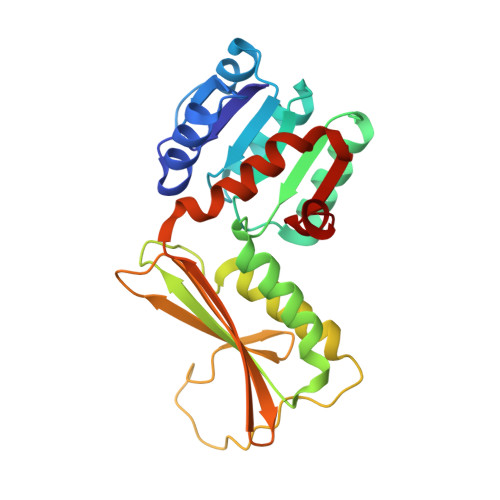The three-dimensional structures of the Mycobacterium tuberculosis dihydrodipicolinate reductase-NADH-2,6-PDC and -NADPH-2,6-PDC complexes. Structural and mutagenic analysis of relaxed nucleotide specificity.
Cirilli, M., Zheng, R., Scapin, G., Blanchard, J.S.(2003) Biochemistry 42: 10644-10650
- PubMed: 12962488
- DOI: https://doi.org/10.1021/bi030044v
- Primary Citation of Related Structures:
1C3V, 1P9L - PubMed Abstract:
Dihydrodipicolinate reductase (DHPR) catalyzes the reduced pyridine nucleotide-dependent reduction of the alpha,beta-unsaturated cyclic imine, dihydrodipicolinate, to generate tetrahydrodipicolinate. This enzyme catalyzes the second step in the bacterial biosynthetic pathway that generates meso-diaminopimelate, a component of bacterial cell walls, and the amino acid L-lysine. The Mycobacterium tuberculosis dapB-encoded DHPR has been cloned, expressed, purified, and crystallized in two ternary complexes with NADH or NADPH and the inhibitor 2,6-pyridinedicarboxylate (2,6-PDC). The structures have been solved using molecular replacement strategies, and the DHPR-NADH-2,6-PDC and DHPR-NADPH-2,6-PDC complexes have been refined against data to 2.3 and 2.5 A, respectively. The M. tuberculosis DHPR is a tetramer of identical subunits, with each subunit composed of two domains connected by two flexible hinge regions. The N-terminal domain binds pyridine nucleotide, while the C-terminal domain is involved in both tetramer formation and substrate/inhibitor binding. The M. tuberculosis DHPR uses NADH and NADPH with nearly equal efficiency based on V/K values. To probe the nature of this substrate specificity, we have generated two mutants, K9A and K11A, residues that are close to the 2'-phosphate of NADPH. These two mutants exhibit decreased specificity for NADPH by factors of 6- and 30-fold, respectively, but the K11A mutant exhibits 270% of WT activity using NADH. The highly conserved structure of the nucleotide fold may permit other enzyme's nucleotide specificity to be altered using similar mutagenic strategies.
- Department of Biochemistry, Albert Einstein College of Medicine, 1300 Morris Park Avenue, Bronx, New York 10461, USA.
Organizational Affiliation:



















